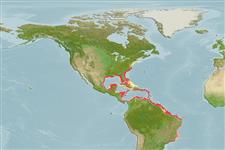>
Carangiformes (Jacks) >
Carangidae (Jacks and pompanos) > Trachinotinae
Etymology: Trachinotus: Greek, trachys, -eia, -ys = rough + Greek,noton = back (Ref. 45335).
More on author: Linnaeus.
Environment: milieu / climate zone / depth range / distribution range
Ecologia
marinhas; estuarina associadas(os) a recifes; intervalo de profundidade 0 - 36 m (Ref. 3277), usually 0 - 30 m (Ref. 55175). Subtropical; 42°N - 25°S, 100°W - 30°W (Ref. 55175)
Western Atlantic: Massachusetts, USA to southeastern Brazil, including Bahamas and many of the West Indies (Ref. 7251). Reports from Africa are based on misidentifications, mostly referring to T. teraia (Ref. 81654).
Length at first maturity / Tamanho / Peso / Idade
Maturity: Lm 54.7, range 48 - ? cm
Max length : 122 cm FL macho/indeterminado; (Ref. 40637); common length : 94.0 cm FL macho/indeterminado; (Ref. 3277); peso máx. Publicado: 36.0 kg (Ref. 5217); Idade máx. registada: 23 anos (Ref. 42149)
Espinhos dorsais (total): 6 - 7; Raios dorsais moles (total): 18-21; Espinhos anais 2-3; Raios anais moles: 16 - 18. Dorsal and anal fins have very long, dark anterior lobes (Ref. 26938). No scutes; a broad patch of orange-yellow on abdomen in front of anal fin; pectoral fins blackish (Ref. 13442).
Adults frequently in channels or holes, over sandy flats, around reefs, and at times over mud bottoms; usually solitary or in small schools; smaller fish tolerate brackish water. Spawn offshore (Ref. 26938). During the summer, juveniles are found in large schools especially in the surf zone along sandy beaches. Adults feed on mollusks, crabs, shrimps, and small fishes; juveniles on benthic invertebrates. Excellent food fish (Ref. 9626). Highly esteemed game fish caught on light tackle (Ref. 26938).
Life cycle and mating behavior
Maturidade | Reprodução | Desova | Ovos | Fecundidade | Larvas
Robins, C.R. and G.C. Ray, 1986. A field guide to Atlantic coast fishes of North America. Houghton Mifflin Company, Boston, U.S.A. 354 p. (Ref. 7251)
Categoria na Lista Vermelha da IUCN (Ref. 130435)
Ameaça para o homem
Harmless
Utilização humana
Pescarias: espécies comerciais; Aquacultura: espécies comerciais; peixe desportivo: sim; Aquário: Aquários públicos
Ferramentas
Relatórios especiais
Descarregue XML
Fontes da internet
Estimates based on models
Preferred temperature (Ref.
123201): 23.2 - 28, mean 26.1 °C (based on 624 cells).
Phylogenetic diversity index (Ref.
82804): PD
50 = 0.5000 [Uniqueness, from 0.5 = low to 2.0 = high].
Bayesian length-weight: a=0.02754 (0.01646 - 0.04607), b=2.85 (2.71 - 2.99), in cm total length, based on LWR estimates for this species & Genus-body shape (Ref.
93245).
Nível Trófico (Ref.
69278): 4.0 ±0.2 se; based on diet studies.
Generation time: 3.9 ( na - na) years. Estimated as median ln(3)/K based on 2
growth studies.
Resiliência (Ref.
120179): Médio, tempo mínimo de duplicação da população 1,4 - 4,4 anos (tm=3; tmax=23).
Fishing Vulnerability (Ref.
59153): Moderate vulnerability (42 of 100).
Nutrients (Ref.
124155): Calcium = 23.2 [8.6, 45.2] mg/100g; Iron = 0.618 [0.318, 1.376] mg/100g; Protein = 20.7 [18.6, 22.7] %; Omega3 = 0.167 [0.087, 0.331] g/100g; Selenium = 19 [8, 47] μg/100g; VitaminA = 11.6 [2.6, 53.6] μg/100g; Zinc = 0.494 [0.296, 0.798] mg/100g (wet weight);
